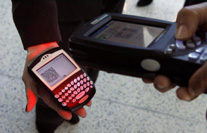Paperless Boarding Pass Pilot
Innovation & Technology
Paperless Boarding Pass | Threat Image Projection | Imaging Technology

The paperless boarding pass pilot enables passengers to download their boarding pass on their cell phones or personal digital assistants (PDAs). This innovative approach streamlines the customer experience while heightening the ability to detect fraudulent boarding passes. Each paperless boarding pass is displayed as an encrypted two-dimensional bar code along with passenger and flight information. TSA security officers use scanners to validate the authenticity of the boarding pass at the checkpoint.
As of March 2012, the pilot was operating at 110 U.S. airports with nine airlines: Alaska, American, British Airways, Continental, Delta, Lufthansa, United, US Airways, and Virgin America.
Due to the rapid expansion of the program, airlines may offer paperless boarding pass at additional airports before they are added to this list. Airlines will make this option available when passengers choose their method of boarding pass delivery.
US Airports
- Albany County (ALB) – Continental, Delta, United
- Albuquerque International (ABQ) – American, Continental, Delta, United
- Amarillo International (AMA) – Continental, United
- Anchorage (ANK) – Alaska, Delta, Continental
- Aspen Pitkin County Sardy Field (ASE_ - United
- Atlanta Hartsfield International (ATL) – American, Continental, Delta, United
- Austin-Bergstrom International (AUS) – Continental, American
- Baltimore-Washington International (BWI) – Continental, United
- Bellingham International (BLI) – Alaska
- Billings Logan (BIL) - Alaska
- Boise/Gowan Field (BOI) - Alaska
- Boston Logan International (BOS) – American, Continental, Delta, United, Virgin
- Burbank, Glendale, Pasadena (BUR) – Alaska
- Charlotte Douglas International (CLT) – Continental, American, US Airways
- Chicago Midway (MDW) – Delta
- Chicago O-Hare International (ORD) – American, Continental, Delta, United
- Cincinnati/Northern Kentucky International (CVG) – American, Delta, United
- Cleveland Hopkins (CLE) – Continental, American, United
- Colorado Springs Municipal (COS) – Continental, United
- Dallas Ft.-Worth (DFW) – Alaska, American, Continental, United
- Dallas Love Field (DAL) – Continental, United
- Dane County Regional (MSN) – American, Delta
- Denver International (DEN) – Alaska, American, Continental, Delta, United
- Des Moines International (DSM) – American, Continental, United
- Detroit Metropolitan Wayne County (DTW) – American, Continental, Delta, United
- El Paso International (ELP) – American, Continental
- Eugene Mahlon Sweet Field (EUG) - Alaska
- Fairbanks International (FAI) – Alaska
- Fresno Air Terminal (FAT) – United, Alaska
- Ft. Lauderdale-Hollywood International (FLL) – Continental
- Glacier Park International (FCA) - Alaska
- Grand Rapids Gerald R. Ford International (GRR) – American, Continental
- Greenville-Spartanburg (GSP) - United
- Guam Antonio B. Won Pat International (GUM) – Continental
- Harrisburg International (MDT) – Continental, United
- Hartford Bradley International (BDL) – American, Delta, Continental, United
- Helena Regional (HLN) - United
- Honolulu (HNC) – Continental, United
- Houston Bush Intercontinental Airport (IAH) – American, Continental, Delta, United
- Indianapolis International (IND) – American, Continental, Delta, United
- Jackson Hole (JAC) – American, United
- Jacksonville (JAX) – Continental, Delta, American
- Juneau International (JNU) - Alaska
- Kansas City International (MCI) – American, Continental, United
- Kahululi Hawaii (OGG) – Alaska, United
- Ketchikan International (KTN) – Alaska
- Kona International (KOA) – Alaska, United
- Las Vegas McCarran (LAS) – Alaska, American, Continental, Delta, United, US Airways, Virgin
- Lihue Alaska (LIH) – Alaska, United
- Little Rock Adams Field (LIT) – Alaska, American, Delta, United
- Long Beach Daugherty Field (LGB) - Alaska
- Los Angeles International (LAX) – Alaska, American, Continental, Delta, United, Virgin
- Louisville (KY) International (SDF) - American
- Lubbock International (LBB) –Continental, United
- Mammoth Yosemite (MMH) – United
- Medford Rogue Valley International (MFR) - Alaska
- Memphis International (MEM) – American, Continental, Delta, United
- Miami International Airport (MIA) – Continental
- Milwaukee General Mitchell International (MKE) – American, Delta
- Minneapolis-St. Paul International (MSP) – Continental, Delta, American
- Missoula International (MSO) - Alaska
- Nashville International (BNA) – American, Delta
- Newark International (EWR) – Continental, Delta, United
- New Orleans International (MSY) – Continental, United
- New York John F. Kennedy (JFK) – American, Delta, United, Virgin
- New York LaGuardia (LGA) – American, Continental, Delta, United
- Northwest Arkansas Regional (XNA) – American, Delta
- Oakland Metropolitan International (OAK) – Alaska, United
- Oklahoma Will Rogers (OKC) – American, Continental, Delta, United
- Ontario International (ONT) – Alaska
- Orange County John Wayne (SNA) – American, Continental, Delta, United
- Orlando International (MCO) – American, Continental, Delta, United
- Palm Springs Regional (PSP) – Alaska
- Pangborn Memorial (Winatchee) (EAT) – Alaska
- Pasco Tri-Cities (PSC)
- Alaska
- Philadelphia International (PHL) – American. Continental, United
- Phoenix Sky Harbor International (PHX) – American, Continental, United
- Pittsburgh International (PIT) – American, Delta, US Air
- Port Columbus International (CMH) – Continental, United
- Portland International (PDX) – Alaska, American, Continental, Delta
- Raleigh-Durham International (RDU) – Continental, Delta, United
- Redmond Roberts Field (RDM) – Alaska
- Sacramento Metropolitan (SMF) – Alaska, Continental, United
- Salt Lake City International (SLC) – American, Continental, Delta, United
- San Antonio International (SAT) – Continental, American, United
- San Diego International (SAN) – Alaska, American, Continental, Delta, United
- San Francisco International (SFO) – American, Continental, United, Virgin
- San Jose International (SJC) – Alaska, Delta, United
- San Juan, Puerto Rico (SJU) – American, Continental, United
- Sonoma County Charles M. Schultz (STS) - Alaska
- Seattle-Tacoma International (SEA) – Alaska, American, Continental, Delta, United
- Sioux Falls Regional (FSD) – United
- Sitka Municipal (SIT) – Alaska
- Southwest Florida International (RSW) – Continental
- Spokane International (GEG) – Alaska
- St. Louis Lambert International (STL) – Continental, United
- Tampa International (TPA) – Continental, United
- Tulsa International (TUL) – American, Continental, United
- Tucson International (TUS) – Alaska
- Washington Dulles International (IAD) – American, Continental, Delta, United
- Washington National (DCA) – Continental, Delta, United
- West Palm Beach, FL (PBI) – Continental
How It Works
 The electronic boarding pass contains a two-dimensional (2-D) barcode encrypted with specific passenger information, such as the traveler's name and flight information.
The electronic boarding pass contains a two-dimensional (2-D) barcode encrypted with specific passenger information, such as the traveler's name and flight information.
At the checkpoint, a TSA travel document checking officer will instruct the passenger on how to scan their cell phone or PDA so that TSA can verify the authenticity of the boarding pass. Passengers will still be required to show photo identification so officers can validate that the name on the boarding pass matches the name on the ID.

